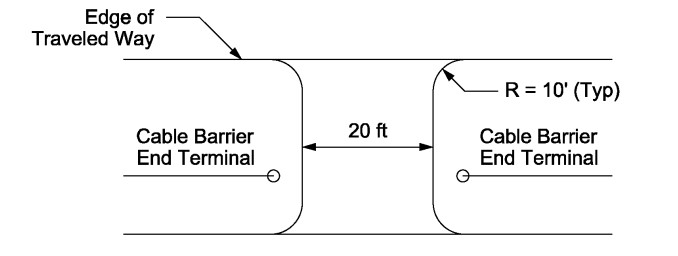17.9 Emergency Crossovers
Emergency crossovers between divided roadways are sometimes necessary for use by official vehicles (e.g., law enforcement, emergency responders, or traffic incident management). Coordination with local and State law enforcement and emergency services personnel is recommended to identify roadway sections where emergency crossovers may be necessary.
17.9.1 Location
When selecting the location for an emergency crossover, the following guidance should be used:
- In general, emergency crossovers should not be provided on urban roadways due to the close spacing of interchanges.
- Where the spacing of interchanges is greater than approximately 3-miles, an emergency crossover should be considered at a favorable location about halfway between interchanges.
- In no case should an emergency crossover be spaced at less than 1-mile intervals.
- All emergency crossovers should be at least 0.5-mile from any structure that crosses over a roadway and at least 1- mile from any ramp terminal or other access connection, such as those serving safety rest areas.
- Emergency crossovers should be located where adequate stopping sight distance is available and where the median is sufficiently wide to permit an official vehicle to turn between the inner lanes.
- When emergency crossovers are desired on divided facilities with continuous concrete barrier for medians not meeting clear zone requirements of , use to bridge the opening.
- Emergency crossovers should not be located in curves requiring superelevation, unless engineering judgement determines the location is safe and reasonable for official use.
- Emergency crossovers should also be as inconspicuous to the traveling public as possible. Refer to the for the appropriate regulatory signing of emergency crossovers.
17.9.2 Construction
Location and type of emergency crossovers should be made a part of the PS&E as a contract item and should be installed as such.
When ending a run of cable barrier, the cable barrier terminals should be located, when possible, behind some protection such as the MBGF, leaving adequate distance to allow an emergency vehicle to maneuver around if necessary as shown in
.

Figure 17-17: Cable Terminals Behind Metal Beam Guard Fence
The terminals can be placed in locations with no protection, but since they provide the anchorage for the cable barrier system, protecting them from possible hits is recommended. These terminals are also gating (meaning they will not prevent a vehicle from going through).
When switching the cable barrier from one median side to the other and the terminals are not protected, overlapping the runs of cable barrier is recommended to provide adequate protection from possible crossovers if the median is wide enough to allow emergency vehicles to utilize it as an effective emergency crossover (see
). The cable barrier anchor terminal should be protected behind guard fence or other barriers from potential impacts. An exposed cable barrier anchor terminal will render the cable system ineffective if damaged by an impact.

Figure 17-18: Recommended Cable Barrier Lap Length

Figure 17-19: Another Typical Layout for Emergency Crossovers
Another typical layout for emergency crossovers is shown in
. Emergency crossovers should be an all-weather surface. It is recommended that they be constructed with a surface treatment that does not invite use. Grade 1 or 2 aggregate or bladed recycled asphalt pavement (RAP) has provided an adequate low-cost surface in some applications.
Emergency crossovers should be approximately 20-ft with return radii of 10-ft. Wider crossovers invite non-emergency use and should only be constructed after an engineering study of the site.
To be inconspicuous to main lane traffic, the surface should be depressed below the shoulder level, if possible.